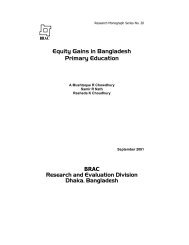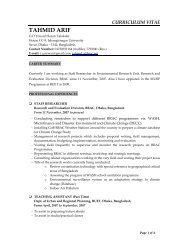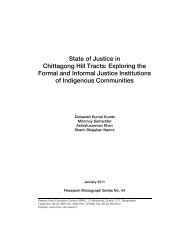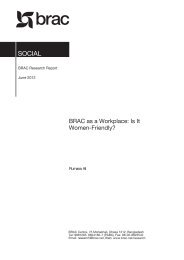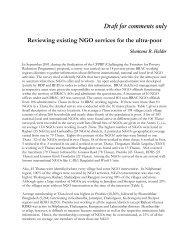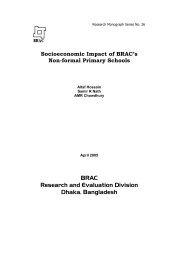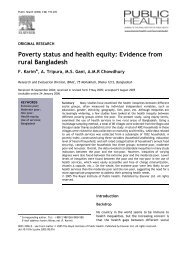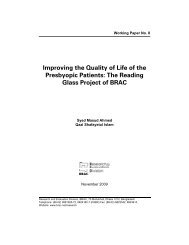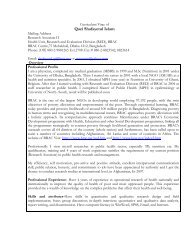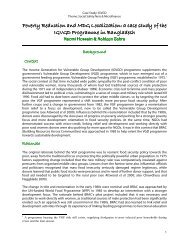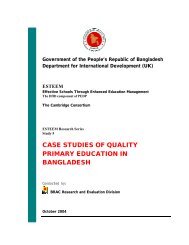Combining health and social protection measures to reach the ultra ...
Combining health and social protection measures to reach the ultra ...
Combining health and social protection measures to reach the ultra ...
Create successful ePaper yourself
Turn your PDF publications into a flip-book with our unique Google optimized e-Paper software.
Access <strong>to</strong> <strong>health</strong><br />
<strong>and</strong> financial burdens <strong>to</strong> individuals, families <strong>and</strong><br />
communities, <strong>and</strong> in some cases <strong>the</strong>y accentuate<br />
marginalization because <strong>the</strong> diseases <strong>and</strong> <strong>the</strong>ir consequences<br />
are highly stigmatized.<br />
Leprosy <strong>and</strong> tuberculosis are among <strong>the</strong> most stigmatized,<br />
<strong>and</strong> individuals known <strong>to</strong> be infected are often excluded from<br />
participating in <strong>social</strong>, economic <strong>and</strong> family life. But<br />
dermatitis <strong>and</strong> blindness from onchocerciasis <strong>and</strong><br />
lymphoedema from filariasis both also result in<br />
marginalization, particularly for women with obvious disease<br />
who may lose family support <strong>and</strong> be subject <strong>to</strong> personal<br />
violence. The psycho<strong>social</strong> impact of such conditions may<br />
lead <strong>to</strong> reluctance <strong>to</strong> present for care, although in addition,<br />
affected individuals often lack <strong>the</strong> financial <strong>and</strong> o<strong>the</strong>r<br />
resources <strong>to</strong> seek treatment.<br />
While <strong>the</strong>re has been extensive research on HIV, including<br />
in low- <strong>and</strong> middle-income countries, limited attention has<br />
been paid <strong>to</strong> marginalization <strong>and</strong> discrimination against<br />
people known <strong>to</strong> be infected, <strong>and</strong> <strong>the</strong> <strong>health</strong> implications of<br />
this. While in many countries legislation provides formal<br />
<strong>protection</strong> of <strong>the</strong>ir rights, People Living With HIV/AIDS<br />
(PLWHA) often face direct <strong>and</strong> structural discrimination in<br />
<strong>the</strong>ir daily lives <strong>and</strong> are severely socioeconomically<br />
disadvantaged. This in part is because HIV is typically<br />
associated with high-risk, marginalized activities – illicit drug<br />
use <strong>and</strong> sex work. Often people in <strong>the</strong>se categories are<br />
discriminated against for o<strong>the</strong>r reasons associated with<br />
gender, class, caste, poverty <strong>and</strong> ethnicity. Differential<br />
treatment by <strong>health</strong> staff exacerbates marginality <strong>and</strong> results<br />
in poorer overall <strong>health</strong> for PLWHA. For example, women who<br />
conceive often receive inadequate or no prenatal care <strong>and</strong> do<br />
not disclose <strong>the</strong>ir HIV status at delivery; disrespectful <strong>and</strong><br />
discrimina<strong>to</strong>ry treatment at <strong>health</strong> care facilities is a primary<br />
barrier <strong>to</strong> disclosure <strong>and</strong> care.<br />
Individuals with physical <strong>and</strong> intellectual impairments are<br />
everywhere poorer, marginalized <strong>and</strong> disabled by <strong>the</strong>ir<br />
communities. Social attitudes shape access <strong>to</strong> care, quality of<br />
care, risk fac<strong>to</strong>rs of complications <strong>and</strong> co-morbidity. Access <strong>to</strong><br />
care is often inhibited because of inappropriate<br />
communication <strong>and</strong> discrimina<strong>to</strong>ry attitudes, systems <strong>and</strong><br />
environments. Although disabled people have received<br />
relatively little attention by public <strong>health</strong> services or <strong>the</strong><br />
medical <strong>and</strong> <strong>health</strong> research community, <strong>the</strong>re is growing<br />
evidence of <strong>the</strong>ir increased vulnerability, including <strong>to</strong> HIV<br />
infection <strong>and</strong> targeted physical, psychological <strong>and</strong> sexual<br />
violence <strong>and</strong> exploitation. Disabled people are less likely than<br />
able-bodied peers <strong>to</strong> be included in <strong>health</strong> education<br />
programmes, <strong>and</strong> information may be inaccessible depending<br />
on <strong>the</strong> nature <strong>and</strong> severity of <strong>the</strong>ir impairments. More<br />
generally, <strong>the</strong>re is a lack of information about <strong>health</strong> <strong>and</strong><br />
<strong>health</strong> services in accessible forms for disabled people, <strong>the</strong>re<br />
is little accessible information about rights, <strong>and</strong> poor physical<br />
access <strong>to</strong> services, buildings <strong>and</strong> transport.<br />
Health status, life chances <strong>and</strong> life outcomes of individuals<br />
are all influenced by such <strong>social</strong> inequalities <strong>and</strong><br />
marginalization. O<strong>the</strong>r people from marginalized groups –<br />
people who are homeless, misuse alcohol <strong>and</strong> illicit drugs, or<br />
are sex workers, for example – routinely experience<br />
O<strong>the</strong>r people from marginalized groups – people who<br />
are homeless, misuse alcohol <strong>and</strong> illicit drugs, or are<br />
sex workers, for example – routinely experience<br />
discrimination, <strong>and</strong> again have poor access <strong>to</strong> <strong>health</strong><br />
services, receive poorer quality care when <strong>the</strong>y do<br />
present, <strong>and</strong> are at higher risk of infectious disease<br />
discrimination, <strong>and</strong> again have poor access <strong>to</strong> <strong>health</strong><br />
services, receive poorer quality care when <strong>the</strong>y do present,<br />
<strong>and</strong> are at higher risk of infectious disease. Increasingly <strong>to</strong>o,<br />
structural violence is punctuated with direct violence – sexual<br />
violence, civil war, terror, <strong>and</strong> <strong>the</strong> long-term effects of war.<br />
This produces fur<strong>the</strong>r violence <strong>and</strong> o<strong>the</strong>r adverse <strong>health</strong><br />
outcomes, including increased gender-based violence as a<br />
result of war, permanent injuries from bombs <strong>and</strong> l<strong>and</strong>mines,<br />
<strong>and</strong> <strong>the</strong> sustained psychological <strong>and</strong> emotional <strong>to</strong>ll of violent<br />
disruption <strong>to</strong> civil society. In addition, damage <strong>to</strong><br />
infrastructure <strong>and</strong> <strong>the</strong> breakdown of basic services results in<br />
an increase in communicable disease, leading <strong>to</strong> fur<strong>the</strong>r<br />
poverty <strong>and</strong> inequality.<br />
One area addressed by <strong>the</strong> Global Forum for Health<br />
Research, where <strong>social</strong> marginalization has affected <strong>health</strong>, is<br />
in relation <strong>to</strong> sexual violence. Gender-based violence,<br />
including sexual violence, is pervasive, with short- <strong>and</strong> longterm<br />
negative effects on women’s physical <strong>and</strong> mental <strong>health</strong>.<br />
Such effects include reproductive <strong>health</strong> problems, chronic<br />
illness, post-traumatic stress disorder, anxiety <strong>and</strong><br />
depression. Women subject <strong>to</strong> domestic violence <strong>and</strong> sexual<br />
violence within <strong>and</strong> beyond <strong>the</strong> home are marginalized<br />
because of assumptions about <strong>the</strong>ir role in provoking <strong>the</strong><br />
abuse. They often lack access <strong>to</strong> counselling centres <strong>and</strong><br />
shelters that could provide short-term <strong>protection</strong> <strong>and</strong> ongoing<br />
support. Little has been done <strong>to</strong> address <strong>the</strong> perpetration of<br />
violence <strong>and</strong> <strong>the</strong> deeply entrenched <strong>and</strong> systemic gender<br />
biases that excuse – <strong>and</strong> even legitimize – men’s violent <strong>and</strong><br />
abusive behaviour. Sexual violence in particular had received<br />
insufficient attention from researchers, clinical practitioners<br />
<strong>and</strong> policy-makers, <strong>and</strong> for a long time was ignored as a<br />
human rights <strong>and</strong> <strong>health</strong> issue. The Sexual Violence Research<br />
Initiative (SVRI) of <strong>the</strong> Forum was launched <strong>to</strong> support<br />
research <strong>and</strong> advocacy in this area in a variety of settings.<br />
The concept of <strong>the</strong> “10/90 gap” acknowledges<br />
<strong>the</strong> inequalities in scientific research that exist between<br />
countries <strong>and</strong> <strong>the</strong> <strong>health</strong> conditions that affect different<br />
populations. But in addition, far less research is conducted<br />
about people who are <strong>social</strong>ly marginalized than about those<br />
with higher <strong>social</strong> status: people with physical impairments<br />
attract less research attention than those without impairments<br />
but with curable conditions; people labelled as having<br />
intellectual impairments receive less attention than those<br />
with common physical impairments; <strong>the</strong> elderly less than<br />
young adults, <strong>and</strong> so on. Even less research is done with<br />
people who are <strong>social</strong>ly marginalized. Rarely are <strong>the</strong>ir<br />
perspectives, insights <strong>and</strong> knowledge, <strong>and</strong> active<br />
participation considered when defining <strong>the</strong> research<br />
060 ✜ Global Forum Update on Research for Health Volume 4



